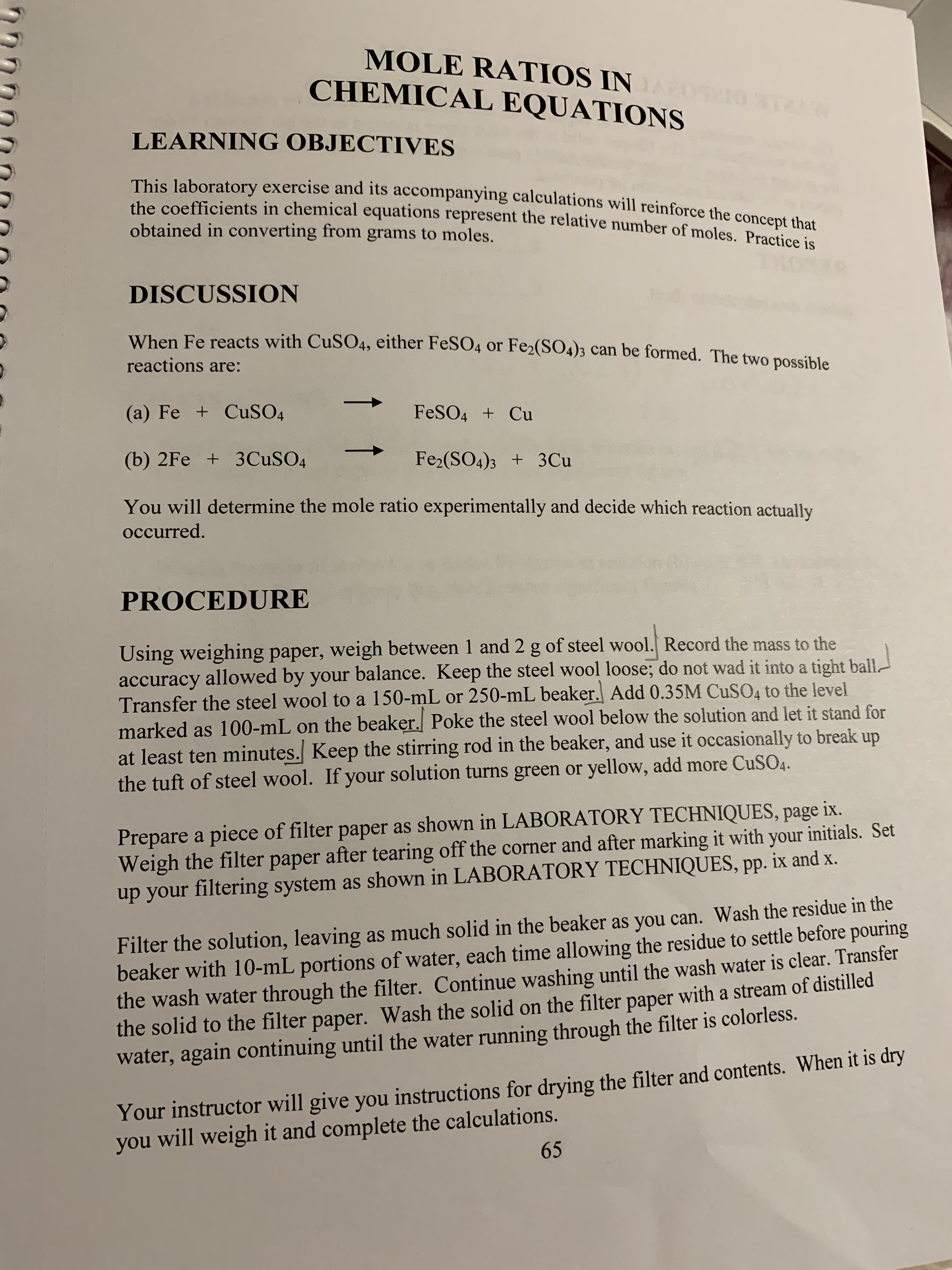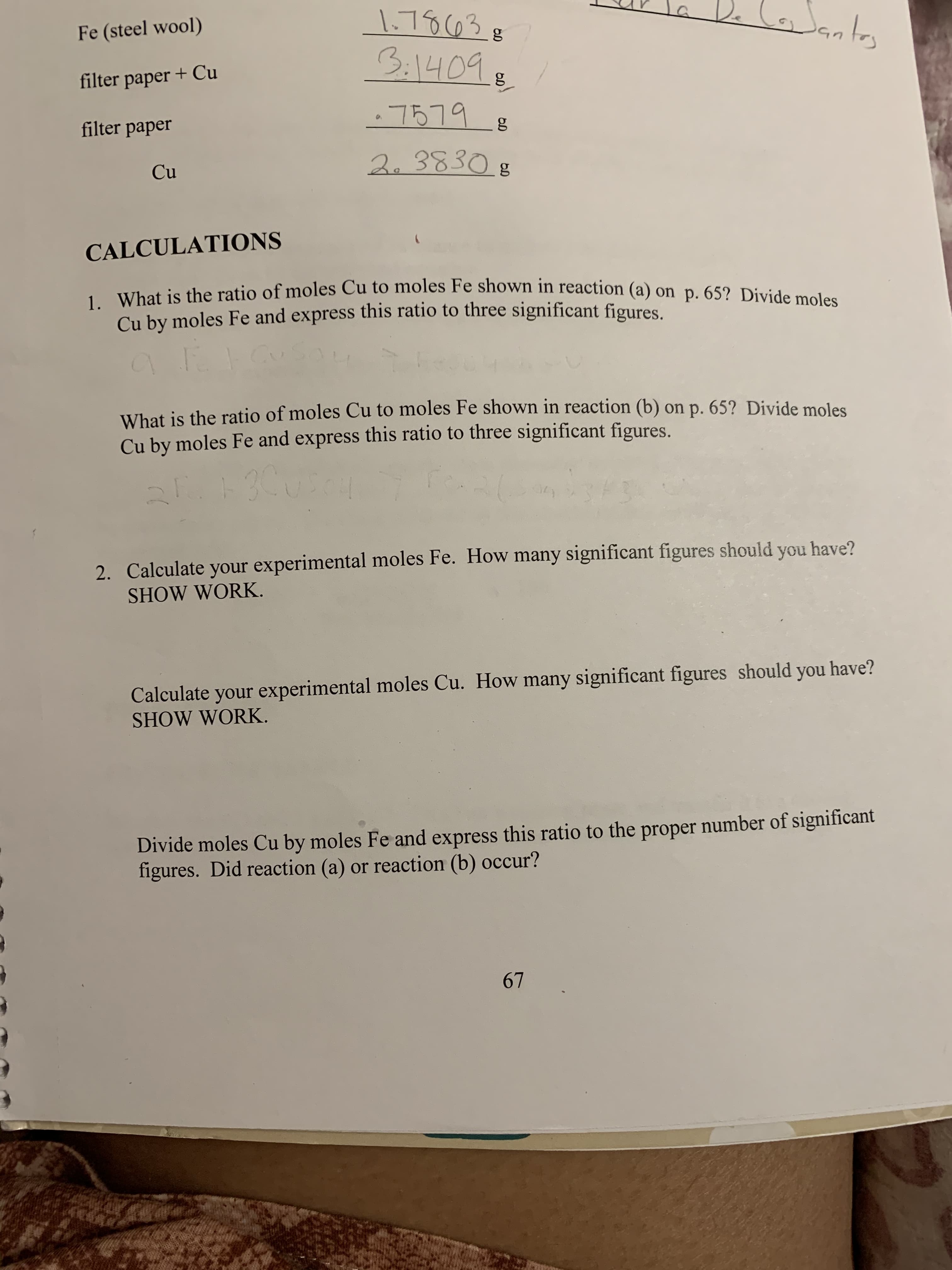MOLE RATIOS IN CHEMICAL EQUATIONS LEARNING OBJECTIVES This laboratory exercise and its accompanying calculations will reinforce the concept that the coefficients in chemical equations represent the relative number of moles. Practice is obtained in converting from grams to moles DISCUSSION When Fe reacts with CuSO4, either FeSO4 or Fe2(SO4)3 can be formed. The two possible reactions are: (a) Fe + CuSO4 FESO4 Cu (b) 2Fe +3CuSO4 Fe2(SO4)3 3 Cu You will determine the mole ratio experimentally and decide which reaction actually occurred. PROCEDURE Using weighing paper, weigh between 1 and 2 g of steel wool. Record the mass to the accuracy allowed by your balance. Keep the steel wool loose; do not wad it into a tight ball. Transfer the steel wool to a 150-mL or 250-mL beaker. Add 0.35M CuSO4 to the level marked as 100-mL on the beaker. Poke the steel wool below the solution and let it stand for at least ten minutes. Keep the stirring rod in the beaker, and use it occasionally to break up the tuft of steel wool. If your solution turns green or yellow, add more CuSO4. Prepare a piece of filter paper as shown in LABORATORY TECHNIQUES, page ix. Weigh the filter paper after tearing off the corner and after marking it with your initials. Set up your filtering system as shown in LABORATORY TECHNIQUES, pp. ix and x. the Filter the solution, leaving as much solid in the beaker as you can. Wash the residue beaker with 10-mL portions of water, each time allowing the residue to settle before pouring the wash water through the filter. Continue washing until the wash water is clear. Transfer the solid to the filter paper. Wash the solid on the filter paper with a stream of distilled water, again continuing until the water running through the filter is colorless. Your instructor will give you instructions for drying the filter and contents. When it is dry you will weigh it and complete the calculations. 65 1-70 03 Fe (steel wool) 31409 filter paper + Cu 7519 filter paper 2. 3830 Cu CALCULATIONS 1. What is the ratio of moles Cu to moles Fe shown in reaction (a) on p. 65? Divide moles Cu by moles Fe and express this ratio to three significant figures What is the ratio of moles Cu to moles Fe shown in reaction (b) on p. 65? Divide moles Cu by moles Fe and express this ratio to three significant figures. 2. Calculate your experimental moles Fe. How many significant figures should you have? SHOW WORK Calculate your experimental moles Cu. How many significant figures should you have? SHOW WORK. Divide moles Cu by moles Fe and express this ratio to the proper number of significant figures. Did reaction (a) or reaction (b) occur? 67
MOLE RATIOS IN CHEMICAL EQUATIONS LEARNING OBJECTIVES This laboratory exercise and its accompanying calculations will reinforce the concept that the coefficients in chemical equations represent the relative number of moles. Practice is obtained in converting from grams to moles DISCUSSION When Fe reacts with CuSO4, either FeSO4 or Fe2(SO4)3 can be formed. The two possible reactions are: (a) Fe + CuSO4 FESO4 Cu (b) 2Fe +3CuSO4 Fe2(SO4)3 3 Cu You will determine the mole ratio experimentally and decide which reaction actually occurred. PROCEDURE Using weighing paper, weigh between 1 and 2 g of steel wool. Record the mass to the accuracy allowed by your balance. Keep the steel wool loose; do not wad it into a tight ball. Transfer the steel wool to a 150-mL or 250-mL beaker. Add 0.35M CuSO4 to the level marked as 100-mL on the beaker. Poke the steel wool below the solution and let it stand for at least ten minutes. Keep the stirring rod in the beaker, and use it occasionally to break up the tuft of steel wool. If your solution turns green or yellow, add more CuSO4. Prepare a piece of filter paper as shown in LABORATORY TECHNIQUES, page ix. Weigh the filter paper after tearing off the corner and after marking it with your initials. Set up your filtering system as shown in LABORATORY TECHNIQUES, pp. ix and x. the Filter the solution, leaving as much solid in the beaker as you can. Wash the residue beaker with 10-mL portions of water, each time allowing the residue to settle before pouring the wash water through the filter. Continue washing until the wash water is clear. Transfer the solid to the filter paper. Wash the solid on the filter paper with a stream of distilled water, again continuing until the water running through the filter is colorless. Your instructor will give you instructions for drying the filter and contents. When it is dry you will weigh it and complete the calculations. 65 1-70 03 Fe (steel wool) 31409 filter paper + Cu 7519 filter paper 2. 3830 Cu CALCULATIONS 1. What is the ratio of moles Cu to moles Fe shown in reaction (a) on p. 65? Divide moles Cu by moles Fe and express this ratio to three significant figures What is the ratio of moles Cu to moles Fe shown in reaction (b) on p. 65? Divide moles Cu by moles Fe and express this ratio to three significant figures. 2. Calculate your experimental moles Fe. How many significant figures should you have? SHOW WORK Calculate your experimental moles Cu. How many significant figures should you have? SHOW WORK. Divide moles Cu by moles Fe and express this ratio to the proper number of significant figures. Did reaction (a) or reaction (b) occur? 67
Introductory Chemistry: A Foundation
9th Edition
ISBN:9781337399425
Author:Steven S. Zumdahl, Donald J. DeCoste
Publisher:Steven S. Zumdahl, Donald J. DeCoste
Chapter9: Chemical Quantities
Section: Chapter Questions
Problem 68AP
Related questions
Question

Transcribed Image Text:MOLE RATIOS IN
CHEMICAL EQUATIONS
LEARNING OBJECTIVES
This laboratory exercise and its accompanying calculations will reinforce the concept that
the coefficients in chemical equations represent the relative number of moles. Practice is
obtained in converting from grams to moles
DISCUSSION
When Fe reacts with CuSO4, either FeSO4 or Fe2(SO4)3 can be formed. The two possible
reactions are:
(a) Fe + CuSO4
FESO4 Cu
(b) 2Fe +3CuSO4
Fe2(SO4)3 3 Cu
You will determine the mole ratio experimentally and decide which reaction actually
occurred.
PROCEDURE
Using weighing paper, weigh between 1 and 2 g of steel wool. Record the mass to the
accuracy allowed by your balance. Keep the steel wool loose; do not wad it into a tight ball.
Transfer the steel wool to a 150-mL or 250-mL beaker. Add 0.35M CuSO4 to the level
marked as 100-mL on the beaker. Poke the steel wool below the solution and let it stand for
at least ten minutes. Keep the stirring rod in the beaker, and use it occasionally to break up
the tuft of steel wool. If your solution turns green or yellow, add more CuSO4.
Prepare a piece of filter paper as shown in LABORATORY TECHNIQUES, page ix.
Weigh the filter paper after tearing off the corner and after marking it with your initials. Set
up your filtering system as shown in LABORATORY TECHNIQUES, pp. ix and x.
the
Filter the solution, leaving as much solid in the beaker as you can. Wash the residue
beaker with 10-mL portions of water, each time allowing the residue to settle before pouring
the wash water through the filter. Continue washing until the wash water is clear. Transfer
the solid to the filter paper. Wash the solid on the filter paper with a stream of distilled
water, again continuing until the water running through the filter is colorless.
Your instructor will give you instructions for drying the filter and contents. When it is dry
you will weigh it and complete the calculations.
65

Transcribed Image Text:1-70 03
Fe (steel wool)
31409
filter paper + Cu
7519
filter paper
2. 3830
Cu
CALCULATIONS
1. What is the ratio of moles Cu to moles Fe shown in reaction (a) on p. 65? Divide moles
Cu by moles Fe and express this ratio to three significant figures
What is the ratio of moles Cu to moles Fe shown in reaction (b) on p. 65? Divide moles
Cu by moles Fe and express this ratio to three significant figures.
2. Calculate your experimental moles Fe. How many significant figures should you have?
SHOW WORK
Calculate your experimental moles Cu. How many significant figures should you have?
SHOW WORK.
Divide moles Cu by moles Fe and express this ratio to the proper number of significant
figures. Did reaction (a) or reaction (b) occur?
67
Expert Solution
This question has been solved!
Explore an expertly crafted, step-by-step solution for a thorough understanding of key concepts.
This is a popular solution!
Trending now
This is a popular solution!
Step by step
Solved in 2 steps with 2 images

Recommended textbooks for you

Introductory Chemistry: A Foundation
Chemistry
ISBN:
9781337399425
Author:
Steven S. Zumdahl, Donald J. DeCoste
Publisher:
Cengage Learning

Chemistry for Engineering Students
Chemistry
ISBN:
9781285199023
Author:
Lawrence S. Brown, Tom Holme
Publisher:
Cengage Learning

Chemistry: Matter and Change
Chemistry
ISBN:
9780078746376
Author:
Dinah Zike, Laurel Dingrando, Nicholas Hainen, Cheryl Wistrom
Publisher:
Glencoe/McGraw-Hill School Pub Co

Introductory Chemistry: A Foundation
Chemistry
ISBN:
9781337399425
Author:
Steven S. Zumdahl, Donald J. DeCoste
Publisher:
Cengage Learning

Chemistry for Engineering Students
Chemistry
ISBN:
9781285199023
Author:
Lawrence S. Brown, Tom Holme
Publisher:
Cengage Learning

Chemistry: Matter and Change
Chemistry
ISBN:
9780078746376
Author:
Dinah Zike, Laurel Dingrando, Nicholas Hainen, Cheryl Wistrom
Publisher:
Glencoe/McGraw-Hill School Pub Co

Chemistry: Principles and Practice
Chemistry
ISBN:
9780534420123
Author:
Daniel L. Reger, Scott R. Goode, David W. Ball, Edward Mercer
Publisher:
Cengage Learning

Chemistry: Principles and Reactions
Chemistry
ISBN:
9781305079373
Author:
William L. Masterton, Cecile N. Hurley
Publisher:
Cengage Learning

Chemistry by OpenStax (2015-05-04)
Chemistry
ISBN:
9781938168390
Author:
Klaus Theopold, Richard H Langley, Paul Flowers, William R. Robinson, Mark Blaser
Publisher:
OpenStax